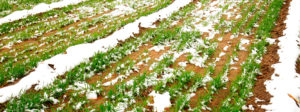Insurance for winter crops can be purchased in spring
Improved weather beginning from the second week of October has helped producers to get on with their delayed harvest allowing for about 78 per cent of the crops being combined by October 23, although overall harvest is still behind the average of the last few years.
While the untimely precipitation with the cold spell of September may have cost producers in yield and quality of their crop, it has improved soil moisture levels  in most areas of the province.
in most areas of the province.
With the warm temperatures of mid-October and improved moisture conditions, producers thinking of seeding crops before the end of the fall have a further positive factor to keep in mind to go ahead with their plans: They can purchase their insurance next spring after their crop has already started to grow.
“We want to give producers as much flexibility as possible when deciding to plant winter crops,” said Daniel Graham, AFSC’s Manager of Business Risk Products.
AFSC no longer sets strict deadlines for sowing winter crops but only has recommended dates (Sept. 20 for north of Bow River and Sept. 30 for the south of the river) for completing the seeding process. That means producers, if they wish to do so, could still use the window of opportunity provided by good weather in November to seed winter crops.
To be eligible for coverage on their winter crops, producers should elect their insurance option and file a Land Report by April 30, 2019. Insurance coverage will be conditional to confirmation that the crop is viable through an AFSC inspection.
“Being able to insure my winter wheat crop in the spring is an excellent way to manage risk,” said Gary Stanford, Alberta Wheat Commission vice-chair and winter wheat grower.
“AFSC’s change in winter cereals insurance means that when seeding past the deadline still works agronomically for your operation, growing it can still be an option.”
